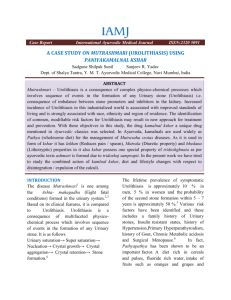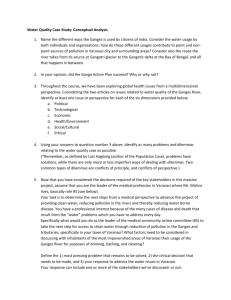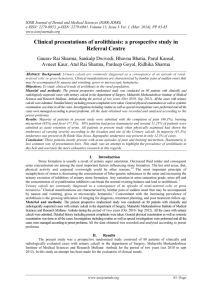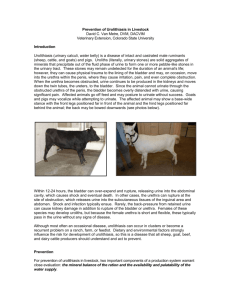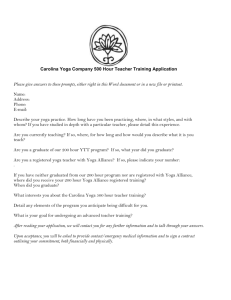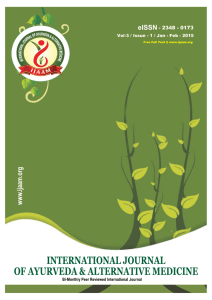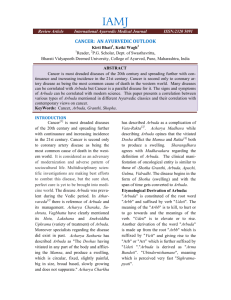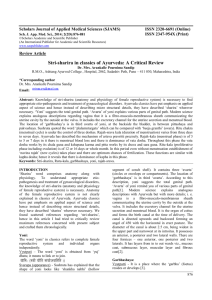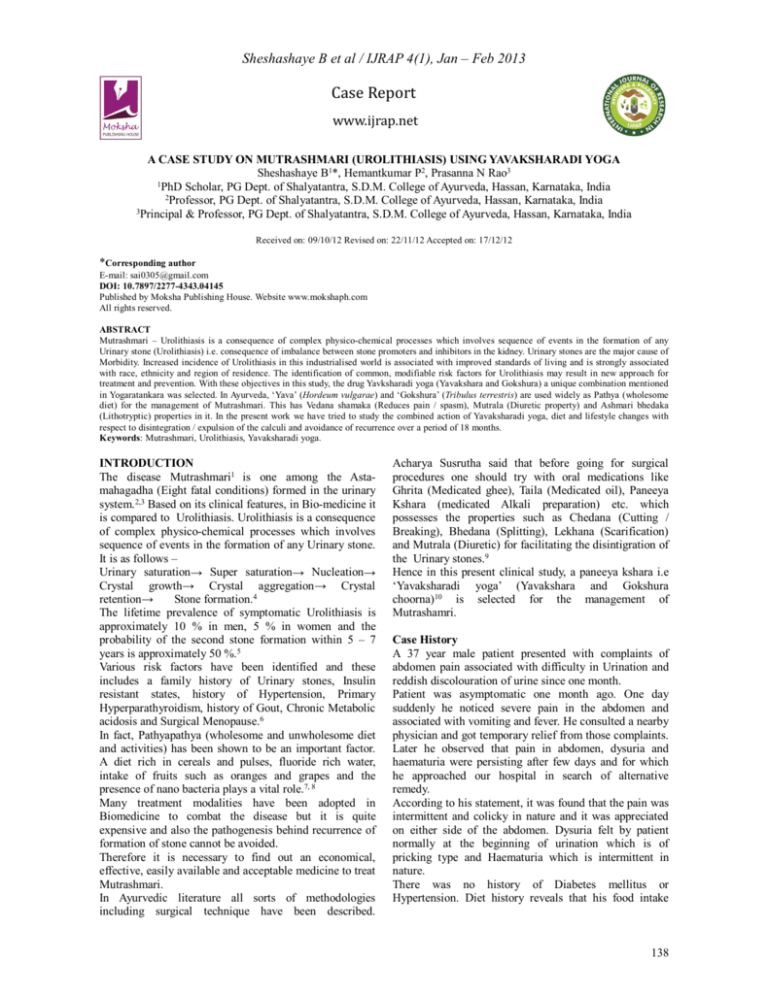
Sheshashaye B et al / IJRAP 4(1), Jan – Feb 2013
Case Report
www.ijrap.net
A CASE STUDY ON MUTRASHMARI (UROLITHIASIS) USING YAVAKSHARADI YOGA
Sheshashaye B1*, Hemantkumar P2, Prasanna N Rao3
1PhD Scholar, PG Dept. of Shalyatantra, S.D.M. College of Ayurveda, Hassan, Karnataka, India
2Professor, PG Dept. of Shalyatantra, S.D.M. College of Ayurveda, Hassan, Karnataka, India
3Principal & Professor, PG Dept. of Shalyatantra, S.D.M. College of Ayurveda, Hassan, Karnataka, India
Received on: 09/10/12 Revised on: 22/11/12 Accepted on: 17/12/12
*Corresponding author
E-mail: sai0305@gmail.com
DOI: 10.7897/2277-4343.04145
Published by Moksha Publishing House. Website www.mokshaph.com
All rights reserved.
ABSTRACT
Mutrashmari – Urolithiasis is a consequence of complex physico-chemical processes which involves sequence of events in the formation of any
Urinary stone (Urolithiasis) i.e. consequence of imbalance between stone promoters and inhibitors in the kidney. Urinary stones are the major cause of
Morbidity. Increased incidence of Urolithiasis in this industrialised world is associated with improved standards of living and is strongly associated
with race, ethnicity and region of residence. The identification of common, modifiable risk factors for Urolithiasis may result in new approach for
treatment and prevention. With these objectives in this study, the drug Yavksharadi yoga (Yavakshara and Gokshura) a unique combination mentioned
in Yogaratankara was selected. In Ayurveda, ‘Yava’ (Hordeum vulgarae) and ‘Gokshura’ (Tribulus terrestris) are used widely as Pathya (wholesome
diet) for the management of Mutrashmari. This has Vedana shamaka (Reduces pain / spasm), Mutrala (Diuretic property) and Ashmari bhedaka
(Lithotryptic) properties in it. In the present work we have tried to study the combined action of Yavaksharadi yoga, diet and lifestyle changes with
respect to disintegration / expulsion of the calculi and avoidance of recurrence over a period of 18 months.
Keywords: Mutrashmari, Urolithiasis, Yavaksharadi yoga.
INTRODUCTION
The disease Mutrashmari1 is one among the Astamahagadha (Eight fatal conditions) formed in the urinary
system. 2,3 Based on its clinical features, in Bio-medicine it
is compared to Urolithiasis. Urolithiasis is a consequence
of complex physico-chemical processes which involves
sequence of events in the formation of any Urinary stone.
It is as follows –
Urinary saturation→ Super saturation→ Nucleation→
Crystal growth→ Crystal aggregation→ Crystal
retention→
Stone formation.4
The lifetime prevalence of symptomatic Urolithiasis is
approximately 10 % in men, 5 % in women and the
probability of the second stone formation within 5 – 7
years is approximately 50 %.5
Various risk factors have been identified and these
includes a family history of Urinary stones, Insulin
resistant states, history of Hypertension, Primary
Hyperparathyroidism, history of Gout, Chronic Metabolic
acidosis and Surgical Menopause.6
In fact, Pathyapathya (wholesome and unwholesome diet
and activities) has been shown to be an important factor.
A diet rich in cereals and pulses, fluoride rich water,
intake of fruits such as oranges and grapes and the
presence of nano bacteria plays a vital role.7, 8
Many treatment modalities have been adopted in
Biomedicine to combat the disease but it is quite
expensive and also the pathogenesis behind recurrence of
formation of stone cannot be avoided.
Therefore it is necessary to find out an economical,
effective, easily available and acceptable medicine to treat
Mutrashmari.
In Ayurvedic literature all sorts of methodologies
including surgical technique have been described.
Acharya Susrutha said that before going for surgical
procedures one should try with oral medications like
Ghrita (Medicated ghee), Taila (Medicated oil), Paneeya
Kshara (medicated Alkali preparation) etc. which
possesses the properties such as Chedana (Cutting /
Breaking), Bhedana (Splitting), Lekhana (Scarification)
and Mutrala (Diuretic) for facilitating the disintigration of
the Urinary stones.9
Hence in this present clinical study, a paneeya kshara i.e
‘Yavaksharadi yoga’ (Yavakshara and Gokshura
choorna)10 is selected for the management of
Mutrashamri.
Case History
A 37 year male patient presented with complaints of
abdomen pain associated with difficulty in Urination and
reddish discolouration of urine since one month.
Patient was asymptomatic one month ago. One day
suddenly he noticed severe pain in the abdomen and
associated with vomiting and fever. He consulted a nearby
physician and got temporary relief from those complaints.
Later he observed that pain in abdomen, dysuria and
haematuria were persisting after few days and for which
he approached our hospital in search of alternative
remedy.
According to his statement, it was found that the pain was
intermittent and colicky in nature and it was appreciated
on either side of the abdomen. Dysuria felt by patient
normally at the beginning of urination which is of
pricking type and Haematuria which is intermittent in
nature.
There was no history of Diabetes mellitus or
Hypertension. Diet history reveals that his food intake
138
Sheshashaye B et al / IJRAP 4(1), Jan – Feb 2013
was irregular in terms of quality and quantity due to his
stressful occupation.
His vitals were within normal limits. On examination of
the abdomen, there was no organomegaly but tenderness
elicited in the both side of the lumbar region and left side
of renal angle.
As advised, Patient underwent Ultrasongraphy of the
Abdomeno-pelvic region on 12th September 2007, and the
report revealed that ‘Two calculi measuring 5mm and 3
mm each were noticed in right kidney along with 10 mm
calculi in the left Kidney and confirmed that it was
Bilateral renal calculi. His Blood and Urine reports were
within normal limits. (Table 1a, b)
As per classics, majority of clinical features of
Mutrashmari such as ‘Vedana in Udara pradesha’ (Pain
abdomen), ‘Sadaha mutrata’ (Burning micturation) and
‘Sarakta mutrata’ (Blood mixed urination) were observed.
On the basis of Nidana (Aetiology) and Rupa (Clinical
features) this clinical condition is diagnosed as
Vatajashmari.11
As Sushruta explains, the use of Paneeya kshara as one
among the major tool to counteract Ashmari. 12
‘Yavaksharadi yoga’ a unique combination described in
Yogaratnakara is administered to him for a period of 1
month. It contains one part of Yavakshara and five parts
Scanning Date
12-09-2007
15-10-2007
18-06-2008
29-01-2009
Blood report
Haemoglobin
Total count
Differential count
Neutrophill
Lymphocytes
Eosinophil
Monocytes
Basophil
ESR
Ahara varga (Food habits)
Vegetables
Cereals
Fruits
Miscellaneous
Healthy food (Kidney)
Vihara (Activities)
of Gokshura choorna. 6 g of this yoga was given thrice a
day with buttermilk, before food for 1 month.
Subject was asked to adhere to the prescribed wholesome
diet and activity chart. (Table 2)
During his first follow up, it was noticed that all the
clinical features were absent except for pain abdomen,
which was less in intensity. He was advised to repeat
Ultrasonography abdomen and pelvis on 15 -10- 2007.
Report reveals that, there was single calculi measuring 5
mm in the lower calyx of Right Kidney. (Table 1)
He was asked to stop all internal medications and
continue only Pathyapathya chart. He was advised to
review after 6 months with Scan report.
Patient visited back on 18th June 2008 for the follow up,
stating that he got completely relieved from pain
abdomen and has experienced neither Dysuria nor
Haematuria till date.
Impression of the 3rd scan report confirmed that, there is
no absolute calculus in the urinary tract. This shows that,
the right renal calculus was also expelled out. Later he
was advised to adhere to Pathyapathya chart till his next
follw-up. (Table 1)
On 29th January 2009, the patient was sent for another
Scan (4th) and the report proved that, there was no
recurrence (new stone formation) of the Mutrashmari in
any part of the urinary tract. (Table 1)
Table 1a: USG reports
Clinical features
Impression
Pain abdomen (severe), Dysuria and
2 Calculi measuring 5mm and 3 mm noted in Right Kidney and
Haematuria
10mm in the Left kidney. (B/L renal calculi)
Pain abdomen (Mild)
Calculus measuring 5 mm in the lower calyx of the Right kidney.
(Right renal calculi)
No any complaints
Essentially normal study
No any complaints
Essentially normal study
Table 1b: Blood and Urine test reports
Report
Urine report
(physical, chemical and microscopic)
14.20%
Volume
7,700cells / cumm
Colour
Appearance
66.00%
Odour
30.00%
pH / Reaction
3.00%
Specific gravity
1.00%
Albumin
0.00%
Glucose
10
Ketone bodies
Bile salts
Bile Pigments
Epithelial cells
Pus cells
Erythrocytes
Bacteria
Cast
Crystals
Table 2: Pathyapathya chart
Pathya
Carrots, Karela (Bitter guard), Potatoes, Radish,
Pumpkin.
Barley, Moong dal, Horsegram
Bananas, Lemon, Apricots, Plums, Apple, Almonds
Coconut water, Lemonade, Aloevera Juice, pineapple
Juice, Butter milk
Papaya, Garlic, Yoghurt
Regular exercises
Report
50 ml
Pale Yellow
Clear
6.5
1.04
2 – 4 cells
1 – 2 cells
-
Apathya
Brinjal, Beans, Lady finger, Capsicum, Tomato,
Cucumber, Palak.
Fine wheat flour (Maida), Oat meal, Bran.
Black Grapes, Amla, Kiwi, Strawberries, Chickoo.
Coffee, Cashew nuts, Chocolates.
Rajmah, Mushroom, Cauliflower, Peas.
Day sleep, Controlling natural urges, Sweating
139
Sheshashaye B et al / IJRAP 4(1), Jan – Feb 2013
Samprapthi gataka
Dosha
Dushya
Agni
Ama
Srotas
Udbhava sthana
Sanchara sthana
Adhistana
Vyaktha sthana
Dusti prakara
Rogamarga
Vyadhi swabhava
Sadyasadhyatha
Table 3: Probable Mode of action or Samprapti vigatana
Mutrashmari
Yavaksharadi yoga and Takra (use)
Tridosha
Tridoshagna
Mutra
Mutrala
Jataragni mandya
Deepana, Pachana
Jataragnimandya janya
Nirama
Mutravaha srotas
Mutrala
Amashaya and Pakvashaya
Shoolagna
Siras, amapakvashayagat Mutravaha srotas
Mutrala
Mutravaha srotas and basthi
Mutrala
Mutravaha srotas and basthi
Mutrala
Sanga
Chedana, Bhedana and Lekhana
Madhyama
Ashmari bedhana
Mutra apravruttijanya vicar
Mutra pravruttikaraka
Kruchchra, Sastrasadhya
Sadya
DISCUSSION
Gokshura contains potassium nitrate in rich quantity,
which acts as an alkalizer.13 Further, when it is combined
with Yavakshara, synergetic action of alkalizer is
enhanced and appreciating the results in disintegration
and elimination of urinary stones from urinary tract.
However the pharmacotherapeutic and pharmacokinetic
effects of ksharatatvam from the Gokshura and
Yavakshara, is a known fact i.e. ashmari chedaka,
mutrakrichrahara. (Table 3)
CONCLUSION
Acharya Sushruta says 'Nidana parivarjana' (Avoidance of
the causative factors) is a major treatment tool for any
diseases. 'Gadanigraha’ another text of Ayurveda
advocates - if one obeys the pathyas, no disease will occur
and if one never mind them and continues apathyas, no
treatment is needed, as it is not going to be cured.
As this is single case study the same intervention can be
used on larger population to see the efficacy of
Yavaksharadi yoga and role of pathya in the management
of Mutrashmari (Urolithiasis).
Benefits of the study
· The correct use of prophylactic and therapeutic
medications decreases the morbidity by its diuretic
and lithotriptic action concerned with expulsion of the
stone.
· To decrease the risk of further stone formation, a
patient is strictly advised to follow certain rules of
conduct, diet and lifestyle regime (pathyapathya)
during the course of Ayurvedic treatment and
thereafter to prevent reoccurrence.
REFERENCES
1. Vaidya Yadavji Trikamji acharya, Krishnadas Academy, Varanasi,
Commentary
Dalhanacharya
Nibhandha
sangraha
and
Gayadasacharya Nyaychandrika Panjika on Sushruta samhitha of
Sushruta, Nidanasthana; Ashmari nidanadyaya: Chapter 3, Verse 3,
4, and 5. Varanasi: Choukhambha Samskrita Samsthana, 6th Edition
(reprinted), 1997; p 276 – 280.
2. Vaidya Yadavji Trikamji acharya, Krishnadas Academy, Varanasi,
Commentary
Dalhanacharya
Nibhandha
sangraha
and
3.
4.
5.
6.
7.
8.
9.
10.
11.
12.
13.
Gayadasacharya Nyaychandrika Panjika on Sushruta samhitha of
Sushruta, Chikitsasthana; Ashmari chikitsam: Chapter 7, Verse 3.
Varanasi: Choukhambha Samskrita Samsthana, 7th Edition reprinted,
1998; p 435 – 441
Vijayarakshita and Srikantadatta, Madhukosha vyakhya on Madava
Nidana of Madavakara, Volume-I Chapter 32, Verse 1. Varanasi:
Choukhambha Samskrita Samsthana, 20th edition, 1993; p 514 –
520.
D.R Smith, editor of General Urology ; Urinary Stones ; Chapter 15,
California : LANGE Medical Publications, 8th edition; p 200 – 216.
Nephrolithiasis - Author: J Stuart Wolf Jr, MD, FACS; Chief Editor:
Bradley
Fields
Schwartz,
DO,
FACS;
http://
emedicine.medscape.com/article/437096-overview.
Davidson’s Principles and Practice of Medicine, 1999, published by
ELBS with Churchill livingstone, 18th edition, p 463 - 466.
Chakrapani datta virachita Ayurveda deepika vyakhya on Charaka
Samhita (Agnivesha krita, Charaka-Drudabala Pratisamskrita),
Chikitsa sthana ; Trimarmeeya chikitsa adyay : Chapter 26, Verse
76; Varanasi: Choukhambha Samskrita Samsthana, 4th edition, 1995,
p 117, 250-251 and 599 – 646.
Dr. M. Swaminathan, Author of Handbook of Food and Nutrition Therapeutic Diets; Chapter 26 ; The Bangalore Printing and
Publishing Co. Ltd., Editon 5 (Reprint); 2003 p 255 – 257.
Vaidya Yadavji Trikamji acharya, Krishnadas Academy, Varanasi,
Commentary
Dalhanacharya
Nibhandha
sangraha
and
Gayadasacharya Nyaychandrika Panjika on Sushruta samhitha of
Sushruta, Chikitsasthana; Ashmari chikitsam: 6th Edition reprinted,
Chapter 7, Verse 3. Varanasi: Choukhambha Samskrita Samsthana,
1997; p 435 – 441.
Vidyotini Hindi vyakhya, on Yogaratnakara, Ashmariroga
chikitsadhikara, uttarardha; Varanasi: Choukhambha Samskrita
Samsthana, 6th edition, 1997; p 72.
Vaidya Yadavji Trikamji acharya, Krishnadas Academy, Varanasi,
Commentary
Dalhanacharya
Nibhandha
sangraha
and
Gayadasacharya Nyaychandrika Panjika on Sushruta samhitha of
Sushruta, Nidanasthana; Ashmari nidanadyaya: Chapter 3, Verse 4,
5, 7 and 10. Varanasi: Choukhambha Samskrita Samsthana, 6th
Edition (reprinted), 1997; p 276 – 280.
Vaidya Yadavji Trikamji acharya, Krishnadas Academy, Varanasi,
Commentary
Dalhanacharya
Nibhandha
sangraha
and
Gayadasacharya Nyaychandrika Panjika on Sushruta samhitha of
Sushruta, Nidanasthana and Chikitsasthana; Ashmari nidanadyaya
and Ashmari chikitsadyaya: Chapter 3 and chapter 7 respectively,
Varanasi: Choukhambha Samskrita Samsthana, 6th Edition
(reprinted), 1997; p 276 – 280 and 435 – 441 respectively.
Ayurveda pharmacopia of India, Vol -1; p 40
Cite this article as:
Sheshashaye B, Hemantkumar P, Prasanna N Rao. A case study on
Mutrashmari (Urolithiasis) using Yavaksharadi yoga. Int. J. Res. Ayur.
Pharm. 2013; 4(1):138-140
Source of support: Nil, Conflict of interest: None Declared
140

